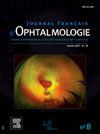槲皮素替代核黄素在胶原交联治疗中的安全性和有效性
IF 1.1
4区 医学
Q3 OPHTHALMOLOGY
引用次数: 0
摘要
目的评价槲皮素替代核黄素治疗胶原交联(CXL)的安全性和有效性。方法将60只澳大利亚-新西兰家兔分为4组:对照组(C组,无UVA暴露)、Tween 20缓冲组(T组,UVA照射)、核黄素组(R组,UVA照射核黄素)、槲皮素组(Q组,UVA照射槲皮素)。在治疗后第7天和第42天对角膜组织进行组织学和生物力学分析。结果生物力学测试显示,与对照组相比,R组的杨氏模量增加了50%,抗拉强度增加了21% (P < 0.05),证实了显著的角膜硬化。相比之下,Q组的杨氏模量增加了18%,但与对照组相比,这没有统计学意义(P > 0.05)。组织学分析显示各组无炎症、角膜水肿或内皮损伤。第7天,R组和Q组前间质中检测到角化细胞凋亡,第42天出现细胞再生。结论槲皮素具有一定的生物力学效应;其对角膜硬化的影响明显低于核黄素,表明其作为光诱导交联剂的效果不佳。ObjectifÉvaluer l ' innocuit本文章由计算机程序翻译,如有差异,请以英文原文为准。
Safety and efficacy of quercetin as an alternative to riboflavin in collagen cross-linking treatment
Purpose
To evaluate the safety and efficacy of quercetin as an alternative to riboflavin in collagen cross-linking (CXL) treatment.
Methods
Australia-New Zealand rabbits (n = 60) were divided into four groups: a control group (C group; no UVA exposure), a Tween 20 buffer group (T group; UVA irradiated), a riboflavin group (R group; UVA irradiated with riboflavin), and a quercetin group (Q group; UVA irradiated with quercetin). The corneal tissues were analyzed histologically and biomechanically on days 7 and 42 post-treatment.
Results
The biomechanical tests demonstrated a 50% increase in Young's modulus and a 21% increase in tensile strength in the R group compared to controls (P < 0.05), confirming significant corneal stiffening. In contrast, the Q group showed an 18% increase in Young's modulus, but this was not statistically significant compared to controls (P > 0.05). Histological analysis revealed no inflammation, corneal edema, or endothelial damage in any group. Keratocyte apoptosis was detected in the anterior stroma of the R and Q groups at day 7, with repopulation occurring by day 42.
Conclusion
While quercetin demonstrated some biomechanical effects; its impact on corneal stiffening was significantly lower than that of riboflavin, indicating its inefficacy as a photo-induced cross-linking agent.
Objectif
Évaluer l’innocuité et l’efficacité de la quercétine comme alternative à la riboflavine dans le traitement de réticulation du collagène (CXL).
Méthodes
Des lapins d’Australie-Nouvelle-Zélande (n = 60) ont été divisés en quatre groupes : un groupe témoin (groupe C; pas d’exposition aux UVA), un groupe tampon Tween 20 (groupe T ; irradié aux UVA), un groupe riboflavine (groupe R ; irradié aux UVA avec de la riboflavine) et un groupe quercétine (groupe Q ; irradié aux UVA avec de la quercétine). Les tissus cornéens ont été analysés histologiquement et biomécaniquement aux jours 7 et 42 après le traitement.
Résultats
Les tests biomécaniques ont démontré une augmentation de 50 % du module de Young et une augmentation de 21 % de la résistance à la traction dans le groupe R par rapport aux témoins (p > 0,05), confirmant un raidissement cornéen significatif. En revanche, le groupe Q a montré une augmentation de 18 % du module de Young, mais celle-ci n’était pas statistiquement significative par rapport aux témoins (p > 0,05). L’analyse histologique n’a révélé aucune inflammation, œdème cornéen ou atteinte endothéliale dans aucun groupe. Une apoptose des kératocytes a été détectée dans le stroma antérieur des groupes R et Q au jour 7, avec une repopulation survenant au jour 42.
Conclusion
Bien que la quercétine ait démontré un certain effet biomécanique, son impact sur le raidissement cornéen était significativement inférieur à celui de la riboflavine, indiquant son inefficacité en tant qu’agent de réticulation photo-induit.
求助全文
通过发布文献求助,成功后即可免费获取论文全文。
去求助
来源期刊
CiteScore
1.10
自引率
8.30%
发文量
317
审稿时长
49 days
期刊介绍:
The Journal français d''ophtalmologie, official publication of the French Society of Ophthalmology, serves the French Speaking Community by publishing excellent research articles, communications of the French Society of Ophthalmology, in-depth reviews, position papers, letters received by the editor and a rich image bank in each issue. The scientific quality is guaranteed through unbiased peer-review, and the journal is member of the Committee of Publication Ethics (COPE). The editors strongly discourage editorial misconduct and in particular if duplicative text from published sources is identified without proper citation, the submission will not be considered for peer review and returned to the authors or immediately rejected.

 求助内容:
求助内容: 应助结果提醒方式:
应助结果提醒方式:


